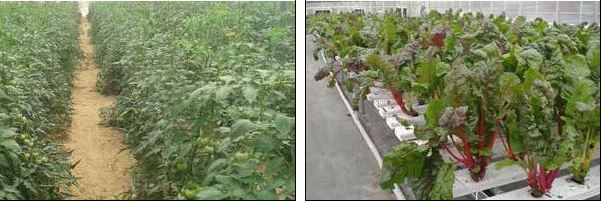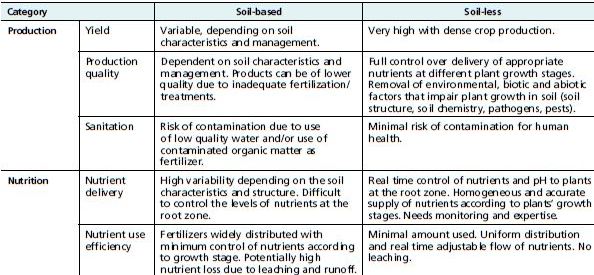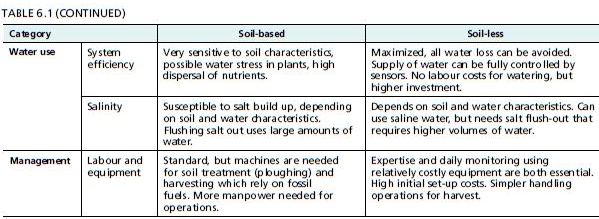6.1 MAJOR DIFFERENCES BETWEEN SOIL AND SOIL-LESS CROP PRODUCTION
There are many similarities between in-ground soil-based agriculture and soil- less production, while the basic plant biology is always the same (Figures 6.1 and 6.2). However it is worth investigating major differences between soil and soil-less production (Table 6.1) in order to bridge the gap between traditional in-ground practices and newer soil-less techniques. Generally, the differences are between the use of fertilizer and consumption of water, the ability to use non-arable land, and overall productivity.
In addition, soil-less agriculture is typically less labour-intensive. Finally, soil-less techniques support monocultures better than does in-ground agriculture.

FIGURE 6.1
Tomatoes (Solanum sp.) growing in soil
FIGURE 62
Swiss chard (Beta sp.) growing in an aquaponic system
6.1.1 Fertilizer
Soil chemistry, especially relating to the availability of nutrients and the dynamics of fertilizers, is a full discipline and fairly complex. Fertilizer addition is required for intensive in-ground cultivation. However, farmers cannot fully control the delivery of these nutrients to plants because of the complex processes occurring in the soil, including biotic and abiotic interactions.
The sum of these interactions determines the availability of the nutrients to the plant roots. Conversely, in soil-less culture, the nutrients are dissolved in a solution that is delivered directly to the plants, and can be tailored specifically to plants' needs. Plants in soil-less culture grow in contained inert media. These media do not interfere with the delivery of nutrients, which can occur in soil. In addition, the media physically support the plants and keep the roots wet and aerated. Moreover, with in-ground agriculture, some of the fertilizer may be lost to weeds and runoff, which can decrease efficiency while causing environmental concerns. Fertilizer is expensive and can make up a large part of the budget for in-ground farming.
The tailored management of fertilizer in soil-less agriculture has two main advantages. First, minimal fertilizer is lost to chemical, biological or physical processes. These losses decrease efficiency and can add to the cost. Second, the nutrient concentrations can be precisely monitored and adjusted according to the requirements of the plants at particular growth stages. This increased control can improve productivity and enhance the quality of the products.
6.1.2 Water use
Water use in hydroponics and aquaponics is much lower than in soil production. Water is lost from in-ground agriculture through evaporation from the surface, transpiration through the leaves, percolation into the subsoil, runoff and weed growth. However, in soil-less culture, the only water use is through crop growth and transpiration through the leaves. The water used is the absolute minimum needed to grow the plants, and only a negligible amount of water is lost for evaporation from the soil-less media. Overall, aquaponics uses only about 10 percent of the water needed to grow the same plant in soil. Thus, soil-less cultivation has great potential to allow production where water is scarce or expensive.
6.1.3 Utilization of non-arable land
Owing to the fact that soil is not needed, soil-less culture methods can be used in areas with non-arable land. One common place for aquaponics is in urban and peri-urban areas that cannot support traditional soil agriculture. Aquaponics can be used on the ground floor, in basements (using grow lights) or on rooftops. Urban-based agriculture can also reduce the production footprint because transport needs are greatly reduced; urban agriculture is local agriculture and contributes to the local economy and local food security. Another important application for aquaponics is in other areas where traditional agriculture cannot be employed, such as in areas that are extremely dry (e.g. deserts and other arid climates), where the soil has high salinity (e.g. costal and estuarine areas or coral sand islands), where the soil quality has been degraded through over-use of fertilizers or lost because of erosion or mining, or in general where arable land is unavailable owing to tenure, purchase costs and land rights. Globally, the arable land suitable for farming is decreasing, and aquaponics is one method that allows people to intensively grow food where in-ground agriculture is difficult or impossible.
6.1.4 Productivity and yield
The most intensive hydroponic culture can achieve 20-25 percent higher yields than the most intensive soil-based culture, although rounded down data by hydroponic experts claim productivity 2-5 times higher. This is when hydroponic culture uses exhaustive greenhouse management, including expensive inputs to sterilize and fertilize the plants. Even without the expensive inputs, the aquaponic techniques described in this publication can equal hydroponic yields and be more productive than soil. The main reason is the fact that soil-less culture allows the farmer to monitor, maintain and adjust the growing conditions for the plants, ensuring optimal real-time nutrient balances, water delivery, pH and temperature. In addition, in soil-less culture, there is no competition with weeds and plant benefit from higher control of pests and diseases.
6.1.5 Reduced workload
Soil-less culture does not require ploughing, tilling, mulching or weeding. On large farms, this equates to lower reliance on agriculture machinery and fossil fuel usage. In small-scale agriculture, this equates to an easier, less labour-intensive exercise for the farmer, especially because most aquaponic units are raised off the ground, which avoids stooping. Harvesting is also a simple procedure compared with soil-based agriculture, and products do not need extensive cleaning to remove soil contamination. Aquaponics is suitable for any gender and many age classes and ability levels of people.
6.1.6 Sustainable monoculture
With soil-less culture, it is entirely possible to grow the same crops in monoculture, year after year. In-ground monocultures are more challenging because the soil becomes "tired", loses fertility, and pests and diseases increase. In soil-less culture, there is simply no soil to lose fertility or show tiredness, and all the biotic and abiotic factors that prevent monoculture are controlled. However, all monocultures require a higher degree of attention to control epidemics compared with polyculture.
6.1.7 Increased complication and high initial investment
The labour required for the initial set-up and installation, as well as the cost, can discourage farmers from adopting soil-less culture. Aquaponics is also more expensive than hydroponics because the plant production units need to be supported by aquaculture installations. Aquaponics is a fairly complex system and requires daily management of three groups of organisms. If any one part of the system fails, the entire system can collapse. In addition, aquaponics requires reliable electricity. Overall, aquaponics is far more complicated than soil-based gardening. Once people are familiar with the process, aquaponics becomes very simple and the daily management becomes easier. There is a learning curve, as with many new technologies, and any new aquaponic farmer needs to be dedicated to learn. Aquaponics is not appropriate for every situation, and the benefits should be weighed against the costs before embarking on any new venture.
TABLE 6.1
Summary table comparing soil-based and soil-less plant production

